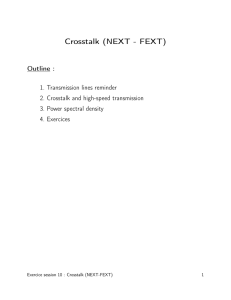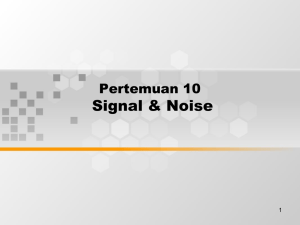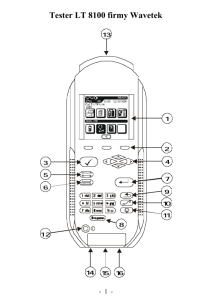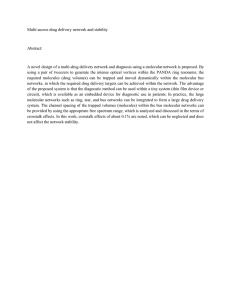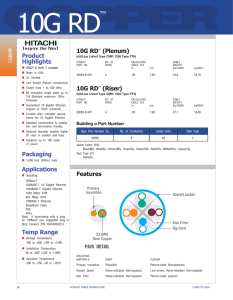new values of cross-talk parameters for twisted pair model
advertisement
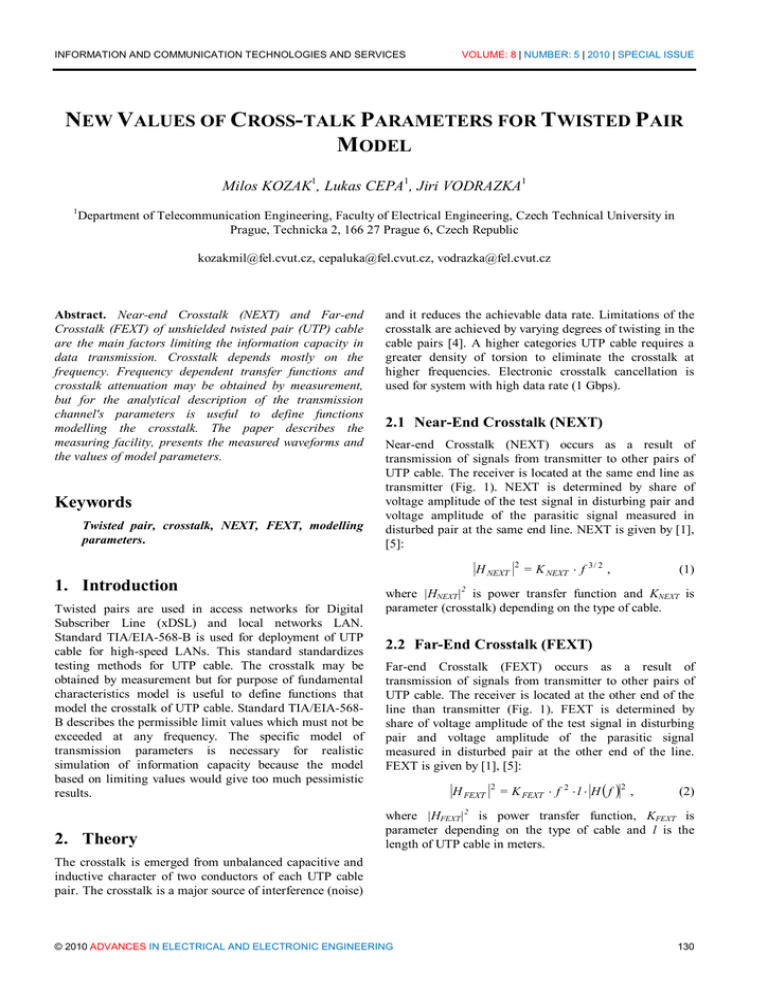
INFORMATION AND COMMUNICATION TECHNOLOGIES AND SERVICES VOLUME: 8 | NUMBER: 5 | 2010 | SPECIAL ISSUE NEW VALUES OF CROSS-TALK PARAMETERS FOR TWISTED PAIR MODEL Milos KOZAK1, Lukas CEPA1, Jiri VODRAZKA1 1 Department of Telecommunication Engineering, Faculty of Electrical Engineering, Czech Technical University in Prague, Technicka 2, 166 27 Prague 6, Czech Republic kozakmil@fel.cvut.cz, cepaluka@fel.cvut.cz, vodrazka@fel.cvut.cz Abstract. Near-end Crosstalk (NEXT) and Far-end Crosstalk (FEXT) of unshielded twisted pair (UTP) cable are the main factors limiting the information capacity in data transmission. Crosstalk depends mostly on the frequency. Frequency dependent transfer functions and crosstalk attenuation may be obtained by measurement, but for the analytical description of the transmission channel's parameters is useful to define functions modelling the crosstalk. The paper describes the measuring facility, presents the measured waveforms and the values of model parameters. Keywords Twisted pair, crosstalk, NEXT, FEXT, modelling parameters. and it reduces the achievable data rate. Limitations of the crosstalk are achieved by varying degrees of twisting in the cable pairs [4]. A higher categories UTP cable requires a greater density of torsion to eliminate the crosstalk at higher frequencies. Electronic crosstalk cancellation is used for system with high data rate (1 Gbps). 2.1 Near-End Crosstalk (NEXT) Near-end Crosstalk (NEXT) occurs as a result of transmission of signals from transmitter to other pairs of UTP cable. The receiver is located at the same end line as transmitter (Fig. 1). NEXT is determined by share of voltage amplitude of the test signal in disturbing pair and voltage amplitude of the parasitic signal measured in disturbed pair at the same end line. NEXT is given by [1], [5]: |H NEXT |2 = K NEXT × f 3 / 2 , 1. Introduction Twisted pairs are used in access networks for Digital Subscriber Line (xDSL) and local networks LAN. Standard TIA/EIA-568-B is used for deployment of UTP cable for high-speed LANs. This standard standardizes testing methods for UTP cable. The crosstalk may be obtained by measurement but for purpose of fundamental characteristics model is useful to define functions that model the crosstalk of UTP cable. Standard TIA/EIA-568B describes the permissible limit values which must not be exceeded at any frequency. The specific model of transmission parameters is necessary for realistic simulation of information capacity because the model based on limiting values would give too much pessimistic results. 2. Theory (1) where |HNEXT|2 is power transfer function and KNEXT is parameter (crosstalk) depending on the type of cable. 2.2 Far-End Crosstalk (FEXT) Far-end Crosstalk (FEXT) occurs as a result of transmission of signals from transmitter to other pairs of UTP cable. The receiver is located at the other end of the line than transmitter (Fig. 1). FEXT is determined by share of voltage amplitude of the test signal in disturbing pair and voltage amplitude of the parasitic signal measured in disturbed pair at the other end of the line. FEXT is given by [1], [5]: |H FEXT |2 = K FEXT × f 2 × l × |H ( f )|2 , (2) where |HFEXT|2 is power transfer function, KFEXT is parameter depending on the type of cable and l is the length of UTP cable in meters. The crosstalk is emerged from unbalanced capacitive and inductive character of two conductors of each UTP cable pair. The crosstalk is a major source of interference (noise) © 2010 ADVANCES IN ELECTRICAL AND ELECTRONIC ENGINEERING 130 INFORMATION AND COMMUNICATION TECHNOLOGIES AND SERVICES VOLUME: 8 | NUMBER: 5 | 2010 | SPECIAL ISSUE The facility consists of: · Vector Network Analyser ZVRE firm RHODE & SCHWARZ, · Agilent 3499B 2-Slot Switch/Control Mainframe, · 2x Agilent 44478A Dual 1x4 RF Multiplexer Module (1,3GHz, 50 Ohm). Dual 1-to-4 multiplexers provide bi-directional switching of signals from DC to 1,3GHz, Fig. 1: The crosstalk type NEXT and FEXT between pairs of the same cable. · baluns 032BF firm North Hill with the frequency bandwidth from 100kHz to 100MHz, 2.3 Method of Crosstalk Measurement The crosstalk measurement uses two North Hill 032BF baluns which acts as an internal measuring bridge between asymmetrical 50 Ω and symmetrical 100 Ω. Baluns work with frequencies from 0,1MHz to 100MHz. · 50 Ω connecting coaxial lines, · measured UTP CAT5e cable (in our experiment length 290 meters). Blocks diagrams are depicted in Fig. 2 and Fig. 3 for measure NEXT and FEXT crosstalk, respectively. This method is based on obtaining of the forward transmission coefficient (S21 parameter) between disturbing pair and disturbed pair in receiving direction at the North Hill 032BF balun in frequency range from 1MHz to 100MHz. Disturbing pair of UTP cable is terminated by adapted impedance. Fig. 2: Block diagram with measuring NEXT crosstalk. Fig. 4: Block diagram of measuring facility of the Department of Telecommunications. The goal of the measuring facility is a faster and more accurate measurement of the secondary parameters, input impedance, Near-end Crosstalk (NEXT) and Far-end Crosstalk (FEXT). Switching of RF switches and processing of values is controlled by a computer. Switching matrix also performs termination of unused pairs. Fig. 3: Block diagram with measuring FEXT crosstalk. 2.4 Measuring Workplace The measurement facility which allows automatic measurement was designed and realized at the Department of Telecommunications of Faculty of electrical engineering of CTU in Prague. This facility is depicted in Fig. 4. 2.5 Crosstalk Modelling Crosstalk modelling is based on obtaining of the crosstalk (parameter K) from equations (1) and (2). This is a generally random variable which depends on the type of cable and the frequency [2]. NEXT and FEXT crosstalk may be modelled directly by interleaved function of measured values of power transfer function NEXT (1) and FEXT (2) of the UTP cable. Model parameters are given by the equations. © 2010 ADVANCES IN ELECTRICAL AND ELECTRONIC ENGINEERING 131 INFORMATION AND COMMUNICATION TECHNOLOGIES AND SERVICES æ ANEXT ( f ) + 15logf ö ÷ 10 ø, è = 10 VOLUME: 8 | NUMBER: 5 | 2010 | SPECIAL ISSUE -ç K NEXT (3) æ AFEXT ( f ) + 20logf + 10logl - A( f ) ö ÷ 10 ø , (4) = 10 è -ç K FEXT where ANEXT and AFEXT are measured crosstalk attenuation and A is the attenuation of the measured section of the line (the attenuation of transmission channel. 3. Measurement Results Measured waveforms of NEXT crosstalk pairs 1-2, 1-3 and 1-4 for both forward and backward direction measurements are depicted in Fig. 5. Figure 5 depicts the waveform of the NEXT crosstalk modelled for the above pairs. KNEXT parameter values were identified by Matlab from waveforms of Fig. 5. Table 1 contains these identified parameter values. The identified KNEXT parameters for forward and backward direction measurements between pairs 1 and 2 are slightly different. The differences between KNEXT parameters of other pairs are much larger. The resulting parameter of model was identified as the arithmetic average of the partial results. Fig. 5: Waveforms of the NEXT crosstalk for forward and backward direction measurements. Tab.1: The values of the identified KNEXT parameters. Pair Forward direction Backward direction 1-2 1-3 1-4 3,56·10-18 4,03·10-18 4,56·10-18 3,57·10-18 2,86·10-18 1,67·10-18 Average 3,38·10-18 The measured and modelled waveforms of FEXT crosstalk for the above pairs of forward and backward direction measurements are depicted in Fig. 6. KFEXT parameter values were identified by Matlab from waveforms of Fig. 6. Table 2 contains these identified parameter values. The identified KFEXT parameters for forward and backward direction measurements are different. Tab.2: The values of the identified KFEXT parameters. Pair Forward direction Backward direction © 2010 ADVANCES IN ELECTRICAL AND ELECTRONIC ENGINEERING 1-2 1-3 2,67·10 -22 2,42·10 -22 1-4 9,34·10 -23 1,19·10 -22 Average 5,90·10 -22 5,04·10 -22 3,03·10-22 132 INFORMATION AND COMMUNICATION TECHNOLOGIES AND SERVICES VOLUME: 8 | NUMBER: 5 | 2010 | SPECIAL ISSUE This work was supported by the Grant MSM6840770014. References [1] [2] [3] [4] [5] VODRÁŽKA, J. Přenosové systémy v přístupové síti. ČVUT, Praha 2006. 196 s. ISBN 80-01-03386-4. PROKOP, T.; VODRÁŽKA, J. Modelling of transmission lines for digital subscriber lines. In: 15th International Conference on Systems, Signals and Image Processing. Bratislava (Slovakia), 2008, p. 53 – 56. ISBN: 978-80-227-2856-0. VODRÁŽKA, J.; JAREŠ, P.; HUBENÝ, T. xDSL Simulator [on line]. Prague: Czech Technical University in Prague, 2006. [cited 2010-1027]. Available at WWW: <http://matlab.feld.cvut.cz/en/view.php?cisloclanku=2006110001>. HUGHES, H. Telecommunication Cables: Design, Manufacture and Installation. Chichester, England: John Wiley Sons Ltd., 1997. ISBN 0-471-97410-2. RAUSCHMAYER, D. J. ADSL/VDSL Principles: A Practical and Precise Study of Asymmetric Digital Subscriber Lines and Very High Speed Digital Subscriber Lines. Indianapolis, USA: Macmillan Technical Publishing, 1999. ISBN 1-578-70015-9. About Authors Fig. 6: Waveforms of the FEXT crosstalk for forward and backward direction measurements. 4. Conclusion This article describes methods for measuring of the Nearend Crosstalk (NEXT) and Far-end Crosstalk (FEXT) with using automatic measurement facility controlled by a computer. Such measuring facility can provide a measured waveforms and subsequent mathematical analysis. The measured values of NEXT and FEXT crosstalk of UTP cable and modelled crosstalk parameters will be used for update the existing parameters in the xDSL Simulator on Matlab Web Server, which is used to evaluate the fundamental characteristics and information capacity of metallic cables. Acknowledgements Milos KOZAK was born in Rakovnik, Czech Republic in 1984. He received the M.S. degree in electrical engineering from the Czech Technical University, Prague, in 2009. He participates in teaching of course of optical communication systems. His research interest is on the application of high-speed optical transmission systems in a data network. Currently he is actively involved in some of the projects on high speed optical modulations, Turbo codes and Communication of Czech Antarctic Station. Lukas CEPA was born in Sumperk, Czech Republic in 1984. He received his M.S. degree in electrical engineering from CTU in Prague in 2009. His research interests include Internet Protocol version 6 (IPv6) and EMC of textile materials. Jiri VODRAZKA was born in Prague, Czech Republic in 1966. He joined the Department of Telecommunication Engineering, FEE, and CTU in Prague in 1996 as a research assistant and received his Ph.D. degree in electrical engineering in 2001. He has been the head of the Transmission Media and Systems scientific group since 2005 and became Associate Professor in 2008. He participates in numerous projects in cooperation with external bodies. Currently he acts also as vice-head of the Department. © 2010 ADVANCES IN ELECTRICAL AND ELECTRONIC ENGINEERING 133


